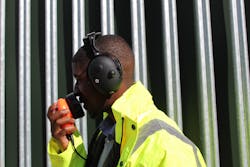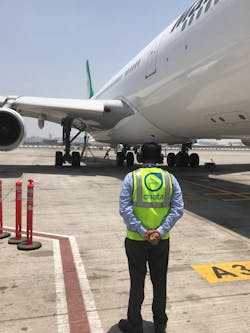dBD Communications Expands Wireless Ramp Solutions to North America
dBD Communications’ Minerva platform is the foundation of its aviation product family - a wireless duplex communication system designed specifically for the demands of ground handling.
In aviation ground support, clear communication is not just a convenience, it’s a necessity. Misunderstandings on the ramp can lead to costly delays or safety risks, and as turnaround times tighten, dependable communication tools have become mission-critical.
At this year’s International GSE Expo in Las Vegas, UK-based dBD Communications is making big strides onto the North American stage, having just announced it has been selected by PrimeFlight Aviation Services to provide advanced wireless systems across all of its ground and cargo handling operations in the region.
The company has established itself as a leader in wireless headset systems globally, providing solutions for airports, airlines, and ground handlers that need reliable, interference-free communication. Now, dBD Communications is bringing its technology to U.S. operators seeking the same clarity and confidence.
To find out more, we spoke with David O’Connell, CEO of dBD Communications, about the company’s growth, its latest innovations, and what makes this GSE Expo such a pivotal moment for the company.
GSW: For readers who might not know dBD Communications, can you give us a snapshot of the company and what you’ll be showcasing in Las Vegas?
O'Connell: dBD Communications has been serving the aviation industry for nearly two decades, primarily across Europe, Middle and Far Eastern regions. We specialize in wireless headset communication systems designed for ramp environments. Our products are widely used by ground handlers, airlines, and MROs who need crystal-clear communication in very noisy conditions.
What we’re bringing to Las Vegas is our latest generation of wireless headsets. Based on the Minerva platform, which is the foundation of our aviation product family, our systems provide reliable, interference-free comms without the tether of cables. They’re robust, easy to deploy, and proven in some of the busiest airports around the world. Now we’re ready to increase our footprint in the North American market.
GSW: Wireless communication isn’t new, but many operators still seem cautious. How does your system address their concerns?
O'Connell: It's true wireless has been around for some time, but not all solutions are created equal. Some systems on the market struggle with range, interference, or durability, which naturally makes operators hesitant. We designed our technology to eliminate those doubts.
Our systems use secure digital protocols that resist interference and provide consistent clarity, even in environments with a lot of competing signals. The headsets are ruggedized to withstand daily ramp use and comfortable enough for long shifts. We also make integration simple - operators can deploy our systems without overhauling existing infrastructure.
We’ve taken the lessons learned from years of use and built a solution that’s ready for the realities of the ramp.
GSW: How have operators around the world responded, and what lessons can North America take from that experience?
O'Connell: In Europe, adoption has grown steadily, particularly in markets where airports and airlines are under constant pressure to maximize efficiency. Once operators see that wireless comms can be both reliable and cost-effective, the barriers fall away.
What North America can take from this is the confidence that the technology is proven. We’re not bringing an untested product to market. Our systems are in use every day at major airports, supporting thousands of flights. That track record means U.S. operators don’t have to wonder if it will work. They can see the evidence from other references around the world and now also in the U.S.
GSW: You mentioned cost-effectiveness. How do you position the value of your systems for ground support operators?
O'Connell: We always encourage operators to look at the bigger picture. Yes, there’s an upfront investment, but the savings quickly outweigh it. Clearer communication reduces the risk of incidents and delays, which can be enormously costly. Turnarounds are faster, safety margins are stronger, and crews can focus on the job instead of fighting their comms.
We’ve had customers tell us the system essentially paid for itself the first time it prevented a delay or mishap. That’s the kind of ROI that speaks directly to both operations and finance teams.
GSW: How do you see the current state of ramp communication worldwide?
O'Connell: I think we’re at a tipping point. For years, ground crews have relied on wired systems that limit movement, or on wireless systems that weren’t always dependable. But the demands on the ramp keep increasing. Airlines want quicker turns, airports are enforcing stricter safety standards, and crews are working with fewer people.
In that environment, communication isn’t optional, it’s infrastructure. Just like a tug or a GPU, wireless comms should be part of the standard toolkit. And the technology has finally matured to the point where reliability is no longer in question.
GSW: The International GSE Expo is a major stage. What does this event mean for dBD Communications?
O'Connell: It’s hugely important for us. We’ve built a strong foundation in other areas of the world, but North America is a critical market, and the Expo is the perfect place to introduce ourselves. Everyone in the industry is here - airlines, handlers, OEMs, regulators - and that makes it an ideal launchpad.
It’s also about listening. We want to hear directly from North American operators about their specific challenges and see how our solutions can best serve them. Every market has its nuances, and GSE Expo gives us the chance to connect, demonstrate, and adapt.
GSW: What sets dBD Communications apart in the competitive landscape?
O'Connell: The bigger carriers have already gone wireless, but they're continuing to evaluate suppliers. America is a very competitive field, and our strength, apart from cost - because we're definitely not the most expensive - is the 24-hour battery life and the range. This is where we beat all the competitors.
Separately, it's all about looking after the client. Our repair time is really quick, generally less than three days. And our reliability is unmatched. We have equipment working in Bangkok for eight years now - and there aren't many headsets that work for eight years continuously.
GSW: How do you see wireless communication evolving in the next few years?
O'Connell: I expect wireless will become the default standard worldwide. As confidence grows, wired systems will fade out. We’ll also see more integration with digital platforms, linking communication with operational data, safety alerts, even predictive analytics.
For dBD Communications, our vision is to keep refining the technology so it’s even more seamless for the user. The goal is always the same: communication that feels effortless, so crews can focus entirely on the aircraft.
GSW: If there’s one message you’d like GSE Expo attendees to take away from your booth, what would it be?
O'Connell: That reliable wireless communication isn’t a luxury, it’s a necessity. We’ve proven it in many airports globally, and now we’re ready to deliver it in North America. Our systems are built for the ramp, tested in the toughest conditions, and backed by a company that understands ground support.
We want the market in America to know we exist. We want people to know who we are and what we can do.
I’d invite anyone at the Expo to come by Booth 8015 to discuss your needs and functions. Once you experience truly clear, dependable wireless communication, you won’t want to go back.
dBD Communications' Minerva platform and its configurations give operators the flexibility to adapt communications to any task — from single pushback to multi-person training — while fitting seamlessly into established ramp procedures.


